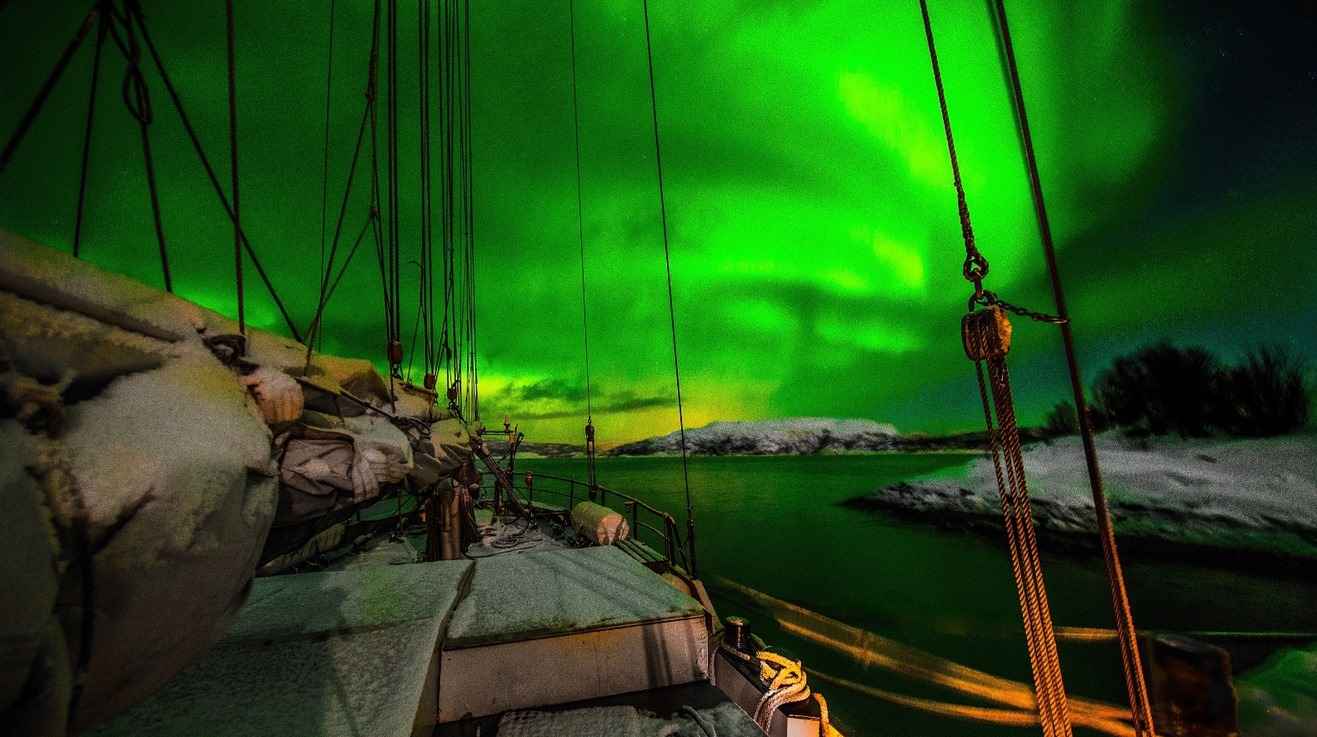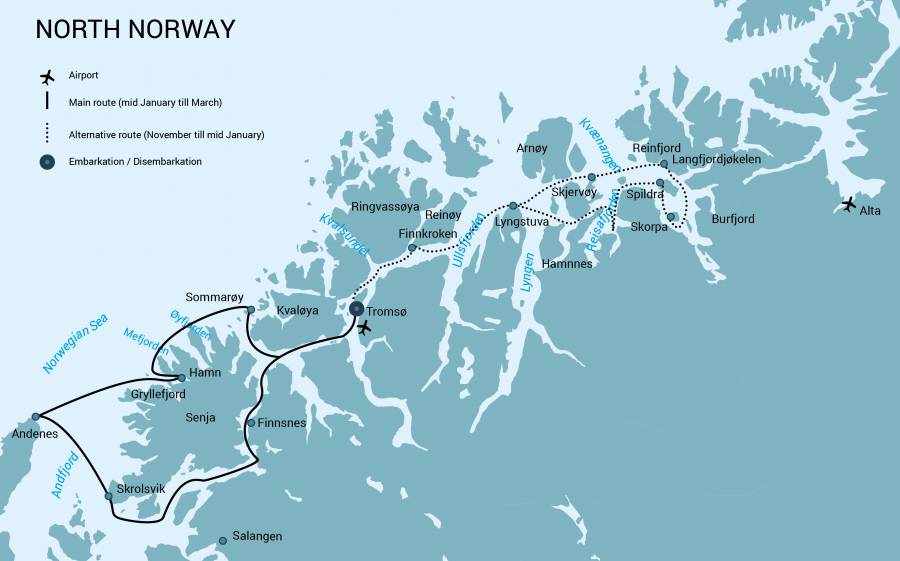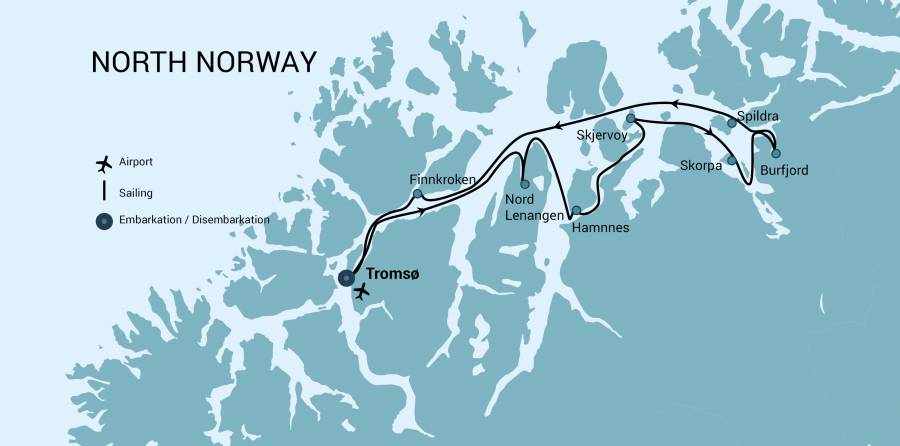The historic sailing vessel, Rembrandt Van Rijn, was originally a herring lugger in the early 1900’s. The vessel was rebuilt as a three-masted passenger sailing schooner and sailed in both Spitsbergen and in the Galápagos until she was refitted in 2011. The vessel underwent a complete rebuilding and refurbishment program to make her comfortable and safe in Arctic waters. It has an experienced crew of 12 persons on board including 2 expedition guides. The ship can accommodate a maximum of 33 passengers in 16 cabins. 1 Triple Private cabin (with shower and toilet and porthole), 6 Twin Private Inside cabins (with shower and toilet, no porthole), 9 Twin Private cabins (with shower and toilet and porthole).
The ship is well suited for expedition cruising among small islands and offers good open deck viewing areas, also when under sail. Arctic expeditions attract independent-minded travelers from around the world with a strong interest in exploring remote regions. The camaraderie and spirit that develops aboard is an important part of the expedition experience. Many departures have several nationalities on board.The 2 inflatable rubber crafts (zodiacs) enable landing and wildlife viewing opportunities in otherwise inaccessible areas. The communication and navigation equipment has been completely renewed according to the latest SOLAS regulations.
Passengers: 33 in 16 cabins
Staff & crew:12
Length:49,50 meters
Breadth:6,65 meters (22,9 ft)
Draft:2,8 meters (8 ft)
Ice class:Suitable to sail in the Svalbard and Greenlandic waters.
Displacement:435 tonnes
Propulsion:2 cummins engines together 550
KWSpeed:6,5 knots average cruising speed
VIDEO TOUR HERE
Northern Norway: Aurora Borealis & Whales Itinerary
PLEASE NOTE: All itineraries are for guidance only. Programs may vary depending on local ice, weather, and wildlife conditions. The onboard expedition leader determines the final itinerary. Flexibility is paramount for expedition cruises. Willingness to compromise on comfort is a basic requirement on board a historic sailing vessel. Important information about the sailing program: The boat is equipped with sails to be used in good conditions (based on open sea, water depth, wind, and time). This is not guaranteed. The captain decides whether to use the sails or the engine. There is no claim to one or the other propulsion method. If sails are used, the crew operates them. Guests must follow the safety instructions of the team. The average cruising speed for s/v Rembrandt van Rijn 6.5 knots.
The North Norway cruise follows the path of more than one kind of whale as it travels among the fjords of Troms. The long Norway nights offer travelers on this expedition an excellent chance to take in the beauty and wonder of the Northern Lights.
South route: (around Senja)
Day 1: Paris of the North
The adventure begins in Tromsø, nicknamed the “Paris of the North,” located in an area rich with Norse and Sámi history. Enjoy exploring this sub-Arctic Norwegian town, said to have been inhabited since the last ice age. All voyages with s/v Rembrandt van Rijn aim at departing from Tromsø in the late afternoon of day one. All passengers of Rembrandt are kindly asked to board the vessel by 17:00.
Day 2: In search of Norway’s whales
The itinerary depends largely on the weather conditions, the amount of daylight during the voyage, and the expected location of the whales. We might sail clockwise or counter-clockwise around the island of Senja.
Day 3 – 6: Whales of the shelf
We will spend the next several days along the north coasts of Senja and Andfjorden, areas where many whales have been spotted in recent years. Keep a look out for sperm whales and other whale species here. Near Andenes, along the edge of the continental shelf, whales dive particularly deep to feed on giant squid.
We may also see white-tailed eagles, one of the largest birds of prey in Europe, vying for their share of the herring. In the afternoon, we find a place for the night in one of the scenic fishing villages nearby, such as Skrolsvik, Andenes, Gryllefjorden, Hamn and/ or Sommarøy. Once the sun has set, you can make short hikes along the coast or in small villages – and maybe even catch sight of the aurora.
Day 7 – 8: Under the northern lightsContinuing our circumnavigation of Senja, we will sail to the small island of Sommarøy. Here there are good opportunities to see the northern lights as well as embark on pleasant hikes. Spend the last morning of the cruise exploring the island’s small bays and white beaches.
On day seven, we sail back to Tromsø and arrive around midday. We’ll have enough time to shop for souvenirs in town, visit a museum, or simply take a walk in the fresh winter air. After spending the last night on board, we disembark on day eight (Saturday) with memories that will accompany you wherever your next adventure lies.
Important note: Tromsø is the base and gateway in which our voyages start and end
These voyages focus on viewing the aurora borealis and whales, and the expedition leader determines the final itinerary during the welcome briefing on day one. The map shows two possible routes that we may take in order to raise our chances for wildlife sightings:
One route (the described one) heads south around the island of Senja, mainly in the period from mid-January until March.
The other route (represented by the dotted line) heads north to the Kvaenangen fjord, very likely to be visited during November to mid-January.
Because of the seasonal occurrence of herring and whales in these fjords, the whale safari cruises take place in winter, when the Northern Norway days are short and the nights long.
Whale watching (orcas and humpbacks) is highly dependent on the variable herring stocks in the area, and this is ultimately unpredictable. Other whales (i.e., sperm whales) are not dependent on herring, which is why we have a good chance of seeing them in specific areas, such as along the south route near Andenes. Our chances of seeing orcas are minimal, while the odds of encountering other species (for instance, humpbacks) are higher. The expedition leader will adapt the sailing plan to maximize your chances of seeing whales.
Additional note: The coasts and fjords of Norway are renowned for their beauty
In the far north of the country, about 350 km (217 miles) north of the Arctic Circle, lie the islands of Kvaløya and Senja. Enormous schools of herring gather in the fjords around these islands to live out the winter.
This abundance of food creates one of the largest concentrations of biomass on Earth, which in turn attracts large numbers of whales. It is these giants of the sea that this voyage is dedicated to finding.
During winter the daylight is limited, but the nighttime hours are far from wasted: North Norway is one of the best areas in the world to see the northern lights, a magical phenomenon that can only be fully appreciated when the sky is clear and dark, with minimal light pollution. This voyage offers ample opportunities to admire the auroras from the remote bays and fishing villages where you’ll spend the night.
Northern Norway: Lights, Hike & Sail
PLEASE NOTE: All itineraries are for guidance only. Programs may vary depending on local ice, weather, and wildlife conditions. The onboard expedition leader determines the final itinerary. Flexibility is paramount for expedition cruises. Willingness to compromise on comfort is a basic requirement on board a historic sailing vessel. Important information about the sailing program: The boat is equipped with sails to be used in good conditions (based on open sea, water depth, wind, and time). This is not guaranteed. The captain decides whether to use the sails or the engine. There is no claim to one or the other propulsion method. If sails are used, the crew operates them. Guests must follow the safety instructions of the team. The average cruising speed for s/v Rembrandt van Rijn 6.5 knots.
During this trip, hikes are offered (with snowshoes if needed). Snowshoeing is easy and for anyone with good health and good physical condition. It requires no technical knowledge. With the use of snowshoes you can move faster and safer on the snow surface.
North route: The programs and routes described here serve only as a rough guide
The overall program, such as the hiking program on land and the itinerary of the ship at sea, will adapt to the local weather, sea, and snow conditions, and may vary considerably from the route shown. Availability of landing sites also plays a role in the selection of the program. The program may also be changed in response to interesting wildlife observations (e.g., whale sightings). The final decision as to where and in what way the hikes will be implemented is ultimately made by the expedition leader on board. For the hiking program, it is recommended that you bring ankle-high, sturdy boots with gaiters. For wet shore landings via our Zodiac boats, please bring insulated rubber boots with anti-slip soles. Hiking poles with deep snow plates are also required. See our equipment list for more details.
The Northern Norway coastline is renowned for its beauty, a forested terrain contoured with rugged mountains and vast fjords that has twice been voted the best travel destination in the world by National Geographic. And it’s not just during the summer months that Norway shows off its splendors, but the winter as well: The mountains are capped with snow, the sun hangs heavy on the skyline, and everything is embraced in a lustrous coat of frost. In the far north, about 500 km (310 miles) northeast of the Arctic Circle, the Lyngen and Kvaenangen fjords can be found, between which we find steep mountain ridges, remote islands, and a wealth of hiking opportunities. These areas provide the ultimate wilderness experience, as ideal for exploration by foot as by sail.
Our itinerary depends largely on weather conditions and the amount of daylight during the voyage. These conditions dictate the route, sailing hours, and our harbors for the night. We intend to explore the fjords and islands by sail and also on foot. In case of heavier snow, we will use our onboard snowshoes.
In winter the amount of daylight is limited, providing about 10 hours of light by the end of February. The dramatic landscape under the low sun and long sunrise / sunset offers great opportunities for photography enthusiasts, but the dark hours will not be wasted: Northern Norway is one of the best areas in the world to see the northern lights, also known as the aurora borealis. This amazing phenomenon can only be seen when the sky is dark and clear. In good weather conditions, this voyage offers ample opportunities to admire and photograph the northern lights from the remote fishing villages and bays where we stay the night. During the voyage you may also see white-tailed eagles, one of the largest birds of prey in Europe, and the more-skittish fish otters. Both species are year-round residents of the Norwegian fjords.
Day 1: Paris of the North
Our adventure begins in Tromsø, nicknamed the “Paris of the North,” located in an area rich with Norse and Sámi history. Enjoy exploring this sub-Arctic Norwegian town, said to have been inhabited since the last ice age. We aim at departing from Tromsø in the evening, sailing through Grøtsundet and Ullsfjorden toward the northeast. All passengers are kindly asked to board the vessel by 17:00.
Day 2: Lighting out toward Lyngen
We arrive in the Nord-Lenangen fjord, just under Lyngsfjella (Lyngen Alps), and the ship may stay there for the night. If conditions permit, you may also make a walk along the coast of the fjord, after which evening glimpses of the northern lights may appear, if the sky is clear enough.
Day 3 – 6: Into the Nordic fjords
We then sail along the base of the Lyngen Alps, across the Lyngen fjord, and may stay for the night in Hamnnes, on the island of Uløya. Hamnnes is an ancient trade and fishing settlement originating in the 17th century, with typical wooden warehouses where residents store dried cod. (In fact, the town still exports this cod for the traditional Mediterranean dish, Bacalhau.) Uløya offers good hiking, often on snowshoes.
From Hamnnes, we sail farther northeast into the Kvaenangen Fjord. Part of the day we sail through the fjords, and in the afternoon we find a harbor to spend the night in one of the scenic fishing villages, such as Skjervøy, Seglvik, Reinfjord, or Burfjord. There are good hiking possibilities in the area, for example on the Island of Spildra, where we might climb the 240-meter-high (788 feet) Staurhammaren, with expansive views over the fjord. Great hikes can also be made in Burfjord, just 50 km (31 miles) from the northerly town of Alta. During the evenings and nights, there are fine opportunities to see auroras if the sky is clear enough.
Day 7 – 8: Below the northern lights
Our next objective is to sail back toward the southwest, staying for the night in Finnkroken, a tiny hamlet that gives you a solid chance of seeing the northern lights. In the morning we embark on a final hike, hopefully with snowshoes, to the 315-meter-high (1,033 feet) Småvasshaugen. On day seven, we sail back to Tromsø and arrive around midday. We will have enough time to shop for souvenirs in town, visit a museum, or simply take a walk in the fresh winter air. After spending the last night on board, we disembark on day eight (Saturday).
Additional note: Hiking / snowshoeing (two hiking options to choose from). At the beginning of the season, there is still snow on the coastline, valleys, and in the mountains. For this reason, we offer the option of snowshoes during our hikes on this voyage.
Snowshoeing is easy for anyone in good physical condition and requires no technical knowledge. With the use of snowshoes, you can move faster and safer on the snow. Snowshoes are available on board (free of charge) and fit all shoe sizes.
As a rule, daily hikes of two to three hours are planned, in the morning and / or afternoon. Approximately 100 to 200 meters (330 to 660 feet) of altitude may be climbed per day, depending on the hike. At midday hikers return for lunch aboard the vessel, but in the event of a full-day hike, participants receive a packed lunch.
For all hikes, guests (maximum of 33) are split into two groups under the guidance of experienced guides who take into account the interests and physical fitness of the participants. Hiking routes cannot be determined in advance, because local conditions (ice, weather, etc.) influence the final program. The map outlines a possible but not final itinerary, as all itineraries are subject to change.
